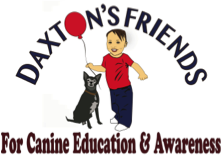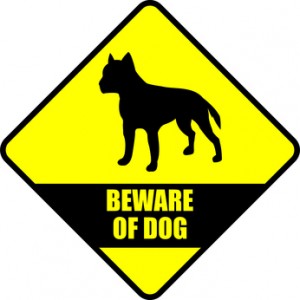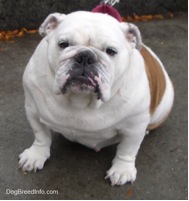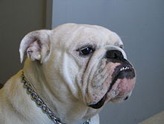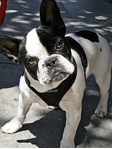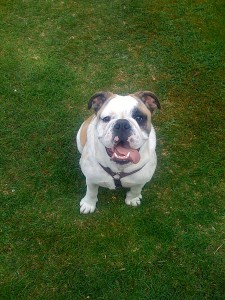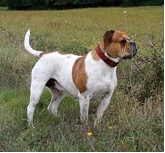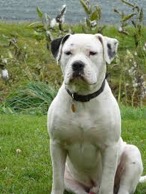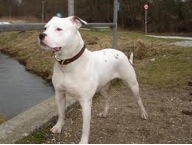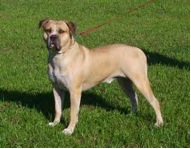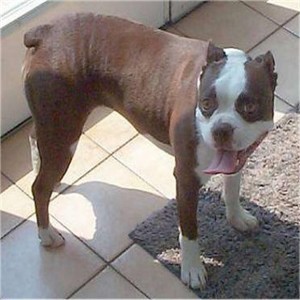“The dog would not let go:” Kenosha police shoot, kill dog after it attacks several people
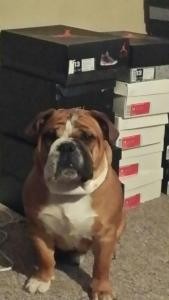 KENOSHA — Police shoot and kill an English bulldog after they say it goes on a rampage, but that’s not all they shot. One victim was also accidentally shot and tased in the chaos.
KENOSHA — Police shoot and kill an English bulldog after they say it goes on a rampage, but that’s not all they shot. One victim was also accidentally shot and tased in the chaos.
Kenosha County deputies say on Wednesday afternoon near 76th St. and 19th Avenue two dogs got loose after a landscaper did not secure a latch to a backyard fence.
Shawn Lievense, is the dogs owners. He says he was not home, but his 12-year-old son was. Lievense says the boy tried to chase down the dogs, and then watched as Kenosha police killed their family pet “Tank”, a 16-month old English bulldog.
Update: Kenosha Sheriff’s Department continues to investigate English bulldog attack
Authorities say the English bulldog “Tank” and another dog, a chihuahua, ran from their owner’s yard. A 30-year-old woman attempted to corral the chihuahua but the bulldog began biting her causing injuries. The 30-year-old woman was later treated for her injuries and released from the hospital.
A 52-year-old woman attempted to help the first woman that was bit. She was able to temporarily leash the bulldog until Kenosha police officers arrived at the scene.
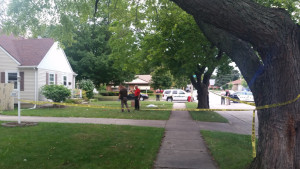 Police mistakenly shoot woman being attacked by dog
Police mistakenly shoot woman being attacked by dog
Jamie Hagen says the incident happened in his front yard. He tells WISN-TV police tried using a Taser gun on the dog, but it wouldn’t stop attacking, so police shot and killed the dog. The woman who was being attacked suffered a gunshot wound to the foot and was taken to a hospital.
Because the woman was shot by an officer, the case will be investigated by another agency – the Kenosha County Sheriff’s Department.
POTENTIALLY DANGEROUS DOG BREEDS
This is a list of dog breeds that have a history of being potentially dangerous to people, especially children. Daxton’s Friends for Canine Education and Awareness understands that any dog has the ability to bite or inflict serious harm to humans. This list consists of several dog breeds that have a higher than average number of recorded human fatalities. Please use extreme caution if you choose to bring one of these breeds into your home. Rental communities and homeowners insurance may restrict many of the dog breeds on this list due to the likelihood of a serious incident.
Pit Bulls, Mastiff, and Rottweiler lead in fatalities and are listed first. The rest of the breeds are listed in alphabetical order:
- American Bulldog
- American Pit Bull Terrier
- American Staffordshire Terrier
- English/Standard Bull Terrier
- Miniature Bull Terrier
- Olde English Bulldog
- Staffordshire Bull Terrier
Mastiffs
- Bullmastiff
- Cane Corso/Italian Mastiff
- Dogo Argentino
- English Mastiff
- Fila Brasileiro
- Dogue de Bordeaux/French Mastiff
- Great Dane/German Mastiff
- Presa Canario
- St. Bernard/Alpine Mastiff
The term Bulldog is most commonly referring to the English Bulldog, although there are variations in the breed, such as the American Bulldog, Olde English Bulldogge, and the French Bulldog. The original Bulldog was used in the blood sport of bull and bear baiting, until those were outlawed in 1835. In New York in the mid 17th century, the Governor brought in Bulldogs to round up wild bulls. The English and French Bulldogs (but not the other variants) were eventually crossed with a pug, and no longer have the attributes of bull baiters. The Olde English Bulldogge is a recreation of the original bull-baiting, pit-fighting bulldog of Elizabethan days and is considered one of the Pit Bull breeds. The American Bulldog is a mix of these original fighting bulldogs and a mastiff type, and is also considered a Pit Bull breed. See Section Two for information about these two Bulldog types.
Section One – The English and the French Bulldog
The English Bulldog:
The French Bulldog:
Breeders have been selectively breeding in hopes of ridding the English Bulldog of aggressive tendencies. This has led to English Bulldogs being easier to train and more likely to follow owner instructions. Despite some recent improvements of the breed, they still need strong and consistent owners. English Bulldogs enjoy limited exercise, such as daily walks, but do not need excessive exercise. Excessive exercise or heat can be detrimental to the health of an English Bulldog. Both the English and the French Bulldogs often have trouble breathing due to the short snouts and deformed palates. These canines can be far more active as puppies, but their activity will decrease as they mature.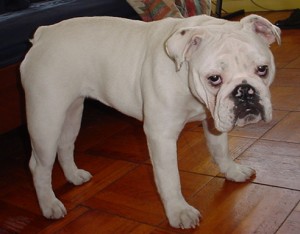
The English Bulldog is a natural guard dog and is considered to be courageous and loyal. The French Bulldog is very small, and is nowadays purely a companion dog – it is more like a Pug than like a Bulldog. English and French Bulldogs love human attention and interaction. They display a mild temperament and are generally gentle with children. However, due to the history of the bull breeds, we do recommend using extreme caution when in contact with the English Bulldog.
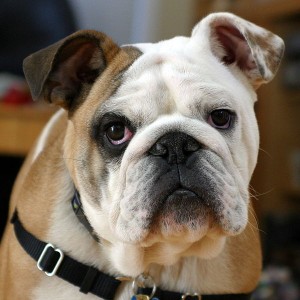
The English Bulldog does well with other family pets that know and understand the household rules, but may not interact in the same way with unfamiliar animals. It can show serious animal aggression. The French Bulldog can sometimes aggravate other dogs by its snorting, as if other dogs interpret the snorting to be a kind of growling. If a dog flips a French Bulldog on its back, or if it falls over during play, the French Bulldog often can’t get onto its feet again on its own due to the size and shape of its head. The French Bulldog can then suffocate if the owner doesn’t quickly turn them back upright.
English and French Bulldogs often make very loving household pets. Families that own them find them to be entertaining and comedic. English and French Bulldogs breathe heavily due to the structure of their skull and jaw. This can lead them to snort when happy and delighted. They also can be difficult to sleep with due to excessive and loud snoring. They are messy eaters and often leave behind trails of drool and slobber. Families who love the breed can easily adjust to life with an English or French Bulldog.
English and French Bulldogs do not do well in warmer climates, unless they have help keeping cool. They do not retain enough heat to be exposed to excessive cold, either. Many require regular cleaning and maintenance under the skin folds of their face and other parts of the body to prevent irritation or skin infections. Proper health maintenance on an English or French Bulldog can be time consuming and costly.
The English Bulldog’s life expectancy is short, ranging from 6 years to 10 years. They usually weigh between 40-50 pounds. Common health issues can include hip dysplasia, Patellar luxation, interdigital cysts, respiratory problems, cherry eye, and allergies. Females often require cesarean deliveries of puppies due to their small pelvis.
The French Bulldog lives about 10 years on average. They weigh between 16 – 25 pounds. Common health problems include dermatitis, various types of hemophilia, and the problems caused by the shortened snout and palate. In some lines with especially large heads, birth has to be done by cesarean section.
Section Two – The Olde English Bulldogge, The American Bulldog, The Boston Bulldog
The Olde English Bulldogge:
The American Bulldog:
Unlike the English and the French Bulldogs, the Olde English Bulldogge and the American Bulldog were not mixed with Pug or other purely companion breeds. The Olde English Bulldogge is a recreation of the original bear-baiting, horse-baiting, pit-fighting bulldog of Elizabethan England. The American Bulldog is a mix of these original bulldogs with a mastiff type1,2.
The Boston Bulldog is smaller than these two, but it is also considered a fighting breed, created by mixing Pit Bull with the Boston Terrier (the Boston Terrier is a slender terrier type that functions mostly as a companion breed)1,2. The Boston Bulldog is no longer very popular as a fighting dog because of its small size, but it retains the characteristics it was originally bred for.
All three of these Bulldogs are considered Pit Bull breeds. For more detailed information, please see ourAmerican Pit Bull Terrier page.
1. Fleig, D, Fighting Dog Breeds, THF Publications Inc, Neptune City NJ, 1996.
2. Jenkins, R and Mollett, K, The Story of the Real Bulldog, THF Publications Inc, Neptune City NJ, 1997.
